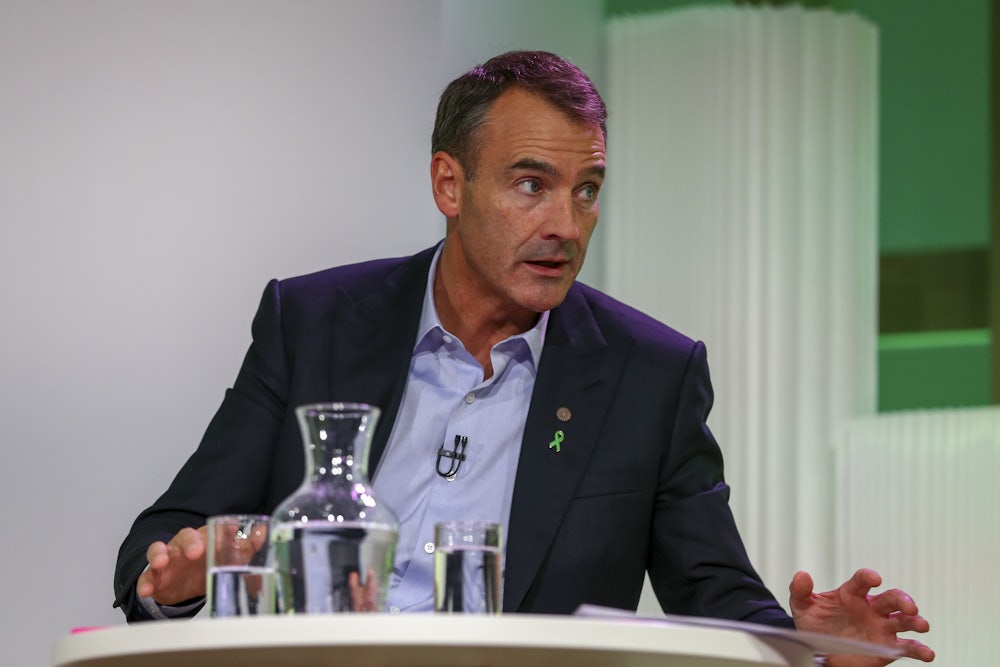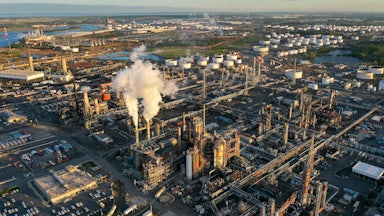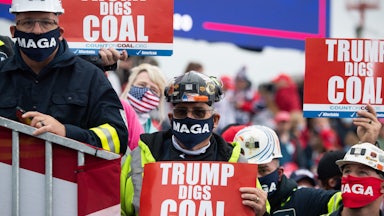Certain oil companies have spent much of the last decade telling the public how committed they are to funding renewable energy. Now, as they continue to rake in record profits from high oil prices, they’re walking back that rhetoric and whatever modest plans accompanied it. This retreat challenges one of the hallmark assumptions of the energy transition, as well as the Inflation Reduction Act: that once solar and wind are cheaper than fossil fuels, they will outcompete them. What if, however, wind and solar aren’t as profitable as dirtier forms of energy?
BP—which made more money than at any point in its 114-year history last year—reportedly intends to scale back earlier plans to shave down its oil and gas output and boost green spending, citing lackluster returns. This has to do with BP’s performance relative to peers with less ambitious emissions-reductions plans; BP has made less money for shareholders than its competitors since Bernard Looney took over as CEO in 2020. Rather than reducing oil and gas output by 40 percent through 2025 as it previously pledged, BP is now aiming for a 25 percent reduction along the same timeline. “We’re going to be driven by value,” Looney said on an earnings call last week. “That’s what we’re going to be driven by. And if we see value, we’ll do it. If we don’t, we won’t.” Looney also indicated on the call that selling off more polluting, less profitable assets to less scrutinized companies—cleaning up BP but not the planet—will continue to be a major piece of its strategy for reaching net-zero emissions. “Portfolio high-grading is a natural piece of running a good business. And we will be doing this, energy transition or no energy transition,” he said, noting that BP aimed to sell off another $10 billion by 2025.
BP scaling back renewables investment amid record profits is a little ironic: The company has consistently argued against governments imposing a tax on its windfall profits on the grounds that such a tax could reduce its spending on the energy transition. Looney reiterated this point when asked about Britain’s modest windfall tax by an analyst last week—although he also added that the U.K., in his view, “needs more gas, not less gas right now.” Researchers at Common Wealth, a British think tank, have found that BP’s payouts to shareholders last year were more than 14 times what they spent on “low carbon” activities.
Shell similarly announced last week that it will not increase its low-carbon spending in 2023. Its preexisting investments in that arena have also come under scrutiny recently. Common Wealth found the company spent 7.5 times as much paying out shareholders as on “Renewables and Energy Solutions” last year. And the nonprofit Global Witness argues that most of the 12 percent of spending the company claims to devote to lower-carbon ventures is in fact going toward rebranded gas projects, with just 1.5 percent spent on wind and solar. On Shell’s earnings call last week, freshly minted CEO Wael Sawan—previously the company’s head of Integrated Gas, Renewables and Energy Solutions—was up-front about Shell’s priorities. Asked by Scotiabank analyst Paul Cheng about whether the company would continue to accept lower returns on renewables (now targeted around 8 to 10 percent) than can be gained from oil and gas investments, Sawan said, essentially, no:
I think on low carbon, let me be, I think, categorical in this. We will drive for strong returns in any business we go into. We cannot justify going for a low return. Our shareholders deserve to see us going after strong returns. If we cannot achieve the double-digit returns in a business, we need to question very hard whether we should continue in that business. Absolutely, we want to continue to go for lower and lower and lower carbon, but it has to be profitable.
What might be interpreted as a moral failing is perfectly rational. Multinational oil companies are not charitable organizations, after all. But this challenges the win-win story that policymakers have pitched—that token public investments can attract massive private cash to get the energy transition up, running, and profitable. The theory undergirding the Inflation Reduction Act is that if the state can make cleaner energy cheaper for consumers and businesses, then investment will follow. Tax incentives, by this view, can allow companies to overcome initial barriers to entry as the state shoulders the risks of newer industries en route to lucrative private-sector returns. Shell’s and BP’s recent candor about retreating from renewables suggests that policy model may be, at the very least, woefully incomplete.
Uppsala University geographer Brett Christophers presciently argued in an academic paper in 2021 that the key factor in whether wind and solar proliferate isn’t the price of renewables but the returns that companies can expect on their investments in them. With their traditional business now more profitable than ever, the gap between the internal rate of return, or IRR, on oil and gas (10 to 15 percent) is more than what they can make on wind and solar, which has an IRR between 4 and 8 percent. “That’s a massive difference from what they’ve been delivering historically,” Christophers told me by phone. “It makes total sense to me from a pure business perspective that they would continue to focus on their core business, especially if they think demand for their products is not going to be declining anytime soon.” That it’s easier to invest in wind and solar is part of the problem, since oil and gas companies have less of a competitive advantage over other firms.
“It’s comparing apples and oranges,” Christophers said. “Oil and gas are businesses of fuel extraction, refining and trade, whereas solar and wind farms are businesses of producing and selling electricity.” The price of electricity can swing even more wildly than the price of oil, giving investors little confidence in what sorts of returns they can expect over the medium and long term. Tax credits and subsidies can make those look more attractive in the near term but don’t create a less volatile spot market for electricity. Power-purchasing agreements with particular buyers of electricity, including states, can offer more reliable revenue streams. But often large-scale renewables projects will need to compete in more volatile power markets in the United States and abroad.
Barring a dramatic overhaul in electricity markets, Christophers said, “the world is stuck on these support mechanisms” that make renewables more attractive investments. This is not, of course, a novel development for energy systems: Fossil fuel companies rake in tens of billions of dollars’ worth of government support each year and benefit from heavy-handed state policies to spur production.
Electricity has never been a free market. So perhaps it’s time to stop pretending renewables will achieve a level of self-sufficiency that has never been demanded of coal, oil, and gas. One alternative to the current model would be a greater role for publicly owned power generation, premised on the idea that governments could develop energy themselves rather than indefinitely shelling out funds to coax corporations into doing so at a profit. The IRA did offer a small gesture in this direction, by making wind and solar tax incentives available to public power providers previously excluded from them.
Economist J.W. Mason suggests, however, that more direct mandates could move the needle more than IRA-style incentives will on their own. “If you just require something, then it might actually be profitable,” he told me. “If you just say no more gas heating hookups, that change is actually going to happen.… It’s kind of hard for companies internally to do something different than what they are accustomed to doing. They may need a mandate or requirement to overcome those barriers.”
The last two years have offered an object lesson in how unresponsive the fossil fuel industry, in particular, is to prices. As fuel prices skyrocketed, oil and gas companies restrained themselves from going on a spending binge to drill as much as possible. That’s not because they care about the planet but because they care about their bottom line: Frackers hemorrhaged cash over the last decade and routinely failed to make a profit in shale, as an abundance of new wells helped drive prices and revenues down. While the same companies can fetch higher fuel prices now, they’re keen to avoid past mistakes and focus on the longer term.
Balance-sheet sustainability and sustainability for the planet are very different things, though. Despite their soaring rhetoric about getting to “net-zero,” oil and gas companies will be in the oil and gas business for as long as they can make money in it, whatever the climate costs. No one should have expected the biggest losers of the energy transition to drive it forward. At least now they’re being honest about that.










